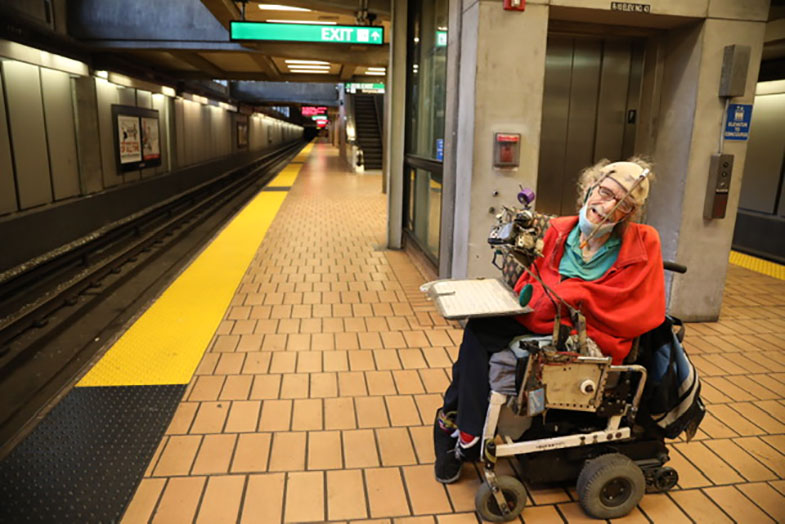
This Tribute of Hale Zukas, written by public service advocate Gail Murray, originally appeared on her personal blog here. It is being reproduced in its entirety for the Bay Area Monitor.
Hale Zukas, a pioneer of national disability rights, died on November 30, 2022 at the age of 79. Despite being born with severe cerebral palsy, he was a man with an indomitable spirit.
My early memories of Hale are of seeing him buzzing around Berkeley and San Francisco in his motorized wheelchair. His speech was limited to short words like “yes” and “no” and grunts. Hale used a pointer on his helmet to slowly spell out words on a letter board attached to his wheelchair. I learned that underneath that helmet was the sharp mind of a strategic thinker.
When his mother was told she should institutionalize Hale, she instead made sure that he was educated. Hale went on to graduate from the University of California at Berkeley in 1971 with degrees in mathematics and Russian. While there, he and other students with disabilities, calling themselves the Rolling Quads, secretly laid asphalt at night for ramps over street curbs. They then could use their wheelchairs on and off campus to move around. First Berkeley and, later, other cities around the nation eventually followed suit by creating cuts in sidewalk curbs to make them accessible. Now curb cuts are standard design at critical locations to accommodate the mobility challenged.
In April 1977 Hale joined 100 other protestors to occupy the federal Health, Education, and Welfare offices in San Francisco for 26 days in the longest non-violent occupation of a federal building in United States history. Similar demonstrations went on around the country until July 28, 1990, when President George H. W. Bush signed the Americans with Disabilities Act into law. Hale and other pioneers permanently altered our society by demanding changes that would allow them to enter buildings, cross streets, ride buses, hold jobs and have access in ways that non-disabled people enjoyed.
I was personally affected by Hale’s passion and determination in an incident when I was on the Board of Directors of BART. During the design of the new fleet of BART cars, I was a strong supporter of poles in the middle of the aisles to hang onto. Standing, I’m tall enough to reach the overhead straps inside the train, but many shorter people and children struggled to remain steady on a crowded train. However, people in wheelchairs objected to the poles, saying they would have difficulty maneuvering around them. The new cars have three doors. We averted a lawsuit by putting the poles in the sections of the front and back of the car and leaving the middle section free of poles for occupants of wheelchairs. This is one example of ways that Hale influenced BART and its operations to serve persons with disabilities.
Hale had many other accomplishments as a founder of the Center for Independent Living and as the vice chair of the Federal Architectural Transportation Barrier Compliance Committee. Despite these achievements, Hale admitted to frustrations and low self-esteem. The Oxford Dictionary’s definition of “indomitable” is “impossible to subdue or defeat.” Hale was indomitable.
When thinking about Hale, I’m reminded of the recent scathing criticism Stanford’s technology department faced for its Elimination of Harmful Language Initiative covering racist, violent and biased language. But some language revisions are needed and worthy. Over the decades we spoke about people like Hale as “disabled.” Parking places and seats on transit were marked “disabled.” But people with physical and mental impairments rose up against being pigeonholed into a singular word. They demanded that our language be changed to “persons with disabilities.” Hale’s remarkable life shows that he was much more than disabled. He was a person who helped change American society—and also happened to have a disability. He was, first, a person. A person with an indomitable spirit. -Gail Murray
Photos courtesy BART.


